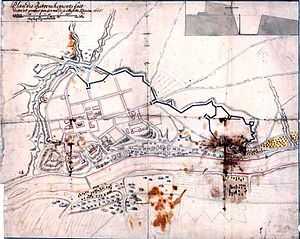Battle of Grodno (1706)
The Battle of Grodno (1706) refers to the battle during the Great Northern War. Grodno was a city of the Polish-Lithuanian Commonwealth at this time.
Battle
The blockade of Grodno by the 20,000 men strong Swedish army took place between January and March 1706. In the city there were about 23,000 Russian troops under the command of general-fieldmarshall Ogilvy as well of general Repnin. On January 13, 1706 the Swedish army coming from Poland crossed the Neman River and squeezed out the Russian cavalry units of Menshikov towards Minsk, cutting of all connections to Russia for the Hrodna garrison. The situation of the Russian troops was made even more difficult after the allied Polish-Lithuanian king Augustus II quickly left Hrodna in Polish direction, taking four Russian dragoon regiments with him. As a result, the Hrodna garrison was left without cavalry which was necessary for reconnaissance and food supplies.
After putting Hrodna under siege, the Swedes occupied Nesvizh and besieged Lyakhavichy. Meanwhile, the Russian garrison of Hrodna suffered big trouble from the lack of food as well as from diseases. This took the lives of about 8,000 soldiers. After the blockade of his main troops in Hrodna Peter the Great had only 12,000 men in Belarus. Being in Minsk with this army he communicated with the besieged garrison via a poruchik named Yakovlev who made his way to Hrodna dressed as a Polish peasant. Besides that 14,000 Ukrainian cossacks of Mazepa were ordered to constantly engage the enemy. Peter I didn't want to have an open battle with Charles XII so far from Russia. Because of that he ordered the Hrodna garrison to hold out until spring when the rivers get free of ice. Then they had to retreat behind the Neman towards Brest and further to the Dnieper what they successfully did until May 1706.
Charles estimated the direction of the Russian retreat wrongly, expecting them to retreat eastwards where he placed his main forces. Having discovered the surprisingly rapid Russian retreat towards south-west too late, he started the pursuit, hoping to catch up the Russians via the Polesia swamps shortcut. However, they proved to be impassable and Charles had to give up the pursuit of the Russians and to seek a battle with the Saxons first.
See also
- Campaign of Grodno
- Charles XII invasion of Poland
References
Sources
- Николай Шефов. Битвы России. Военно-историческая библиотека. М., 2002.
- Russian Army at Grodno 1706
